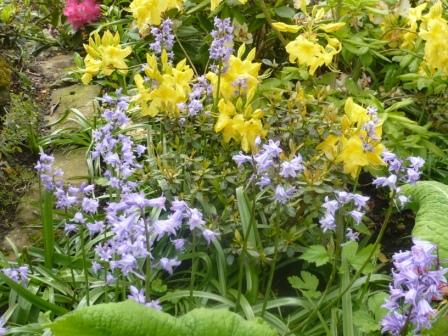Tidy Up Your Untidy Bluebells
Bluebells can become invasive in the garden and become too much of a good thing. The bulbs go deep down into good soil and if you want to remove them they must be dug out totally. The white bulbs throw off little bulbils and they will grow back unless you clean up the soil to at least 12 “. If your garden veers towards the more formal you may wish to tidy up by removing the bluebells.
After flowering the leaves of Bluebells loose the turgid nature and spread in a slimy manner over an 18″ diameter inhibiting other follow-on plants. To tidy up I pull up the clumps of leaves, stalks, seed heads and all to clear the ground. They come up very easily breaking off from the bulb and leaving that for future years. If I do it early enough the bulbs will weaken and flowers be poorer next year but as you may guess I am no great lover of Bluebells except in woodland situations.
Varieties of Bluebell
Spanish Bluebells Hyacinthoides hispanica are more invasive and are pushing our own native species out. If the flower spike is stiff and upright, flowers broadly spreading and petals usually not rolled back with clear blue Anthers you have Spanish Bluebells Hyacinthoides hispanica. They are unscented. Italian Bluebells Hyacinthoides italic are quite similar but less invasive.
English bluebells Hyacinthoides non-scripta have narrow leaves with scented flowers of straight-sided bells, petals that are rolled back (recurved) and Anthers which are creamy-white. The nodding, violet-blue flowers of these hardy, native bulbs attract insects to their delicately scented flowers. Bluebells grow best under the dappled shade of deciduous trees. It is illegal to take these plants from the wild, they must be acquired from a reputable source.
There are also hybrids of the two key varieties and most of my Bluebells must be the Spanish variety so out they will come.

These White Bluebells are running to seed. Take off seed heads to stop profligate self sowing.
Naming The Bluebell
- The botanic name is now Scilla campanulata and you can often buy bulbs under this name.
- Previously they were classified as Endymion who was a mythical Greek. Endymion campanulatus, Endymion hispanicus, Endymion patulus, and Scilla hispanica have also been used.
- Another common name ‘Wood Hyacinth’, seems to describe the plant and its preferred location.
- There are now many hybrid ‘Bluebells’ mixed with these white bells with names that indicate the colour eg Mount Everest (white) and Azalea (pink).
Bluebells look and smell marvelous in a deciduous wood but the Spanish bluebell in your garden can be a thug that needs tidying up after flowering. If after all this you wish to buy Bluebells you can do so from Thompson Morgan

Where to see Native Bluebells
Hackfall Wood Ripon.
Trench Wood Worcester
Winkworth Arboretum Surrey
Ashridge Estate, Berkhamsted, Buckinghamshire
Duncliffe Wood, Stour Row, Shaftesbury, Dorset
Heartwood Forest, Sandridge, Hertfordshire
Burroughs Wood, Ratby, Leicestershire
Hardcastle Crags, Hebden Bridge, West Yorkshire
Coed Cefn, Chrickhowell, Powys, Wales
Glen Finglas (Brig o’Turk) Trossachs National Park, Scotland


3 thoughts on “Tidy Up Your Untidy Bluebells”
I am sticking to plant pots on the top of my ‘personhole’ covers as the link above didn’t work when I tried.
Comments are closed.